English Translation of the Wikipedia page " La ReFeRe" / by Rosemary Border
home
The ReFeRe
The ReFeRe (Réseaux Ferrés Réunis – pronounced
ray-fay-ray), the United Rail Network, is an 'archipelago' of miniature rail
networks on a scale of 1 in
87 created in what their designer calls
altermodélistique : we are dealing here with an imaginary world and with
somewhat innovative modelling techniques.
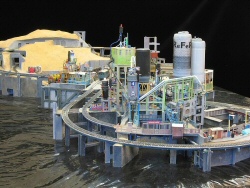 The Oasis. In the foreground : the Adhesion Centre
The Oasis. In the foreground : the Adhesion Centre
An imaginary world
On the edge of a poor country, poor because it lacks
resources, in a cool temperate climate somewhere on Earth, at the present time.
Barren islets, where neither grass nor trees can grow,
rise up out of a flat expanse of an indefinable and constantly changing
substance known as the stroma. These islands are taken up with buildings
(residential, industrial and railway-related), slag heaps, refuse dumps... all
linked by a narrow gauge rail network. To get from one islet to another the
trains make use of vehicles on air cushions, known as aéroglisseurs –
hovercars.
The inhabitants are industrious and ingenious; they
work mostly through the Internet, broadcast on radio waves (there is no
telephone connection). One particular
building material is used everywhere: a sort of fibrocement known as concrète,
although it bears little relation to the concrete used in our world. Concrète
comes in slabs and is stuck together. Platforms, walls, bridges, roads,
buildings, the bodywork of trucks and carriages
and propulsion units, footbridges, dustbins and guardrails are all
fashioned from concrète – and painted in colours which are often difficult to
put a name to.
The ReFeRe a has a total monopoly on transport systems
(there are no roads, nor canals…) Its professional activity is to transport
people, fuel and the parts and materials it requires in order to do its job;
and that job consists of making the trains run. On the rail networks of the
ReFeRe, haulage is entrusted to propulsion units powered by fuel oil (no
overhead electrics here) and the length of the trains is severely limited. All
the vehicles are built on site on recycled chassis imported from elsewhere. The
characteristics of this universe were defined from the start in order to meet
the technical requirements of construction.
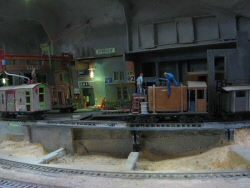 The
Mine, the subterranean station of the Oasis
The
Mine, the subterranean station of the Oasis
Execution
Building work on the ReFeRe began in the year 2000,
initially in a loft at Boulogne-Billancourt
(near Paris, France),
then in a well-lit workshop at Vignol in the Nièvre (Burgundy). The scale is the classic H0 (or
HO), that is: 1 in
87. The original track and rolling stock are N gauge (1 in 160) ; the space between
the rails corresponds to a real life distance of 77.7 centimetres,
ie narrow gauge.
The locomotives (2 rails, direct current) and the
carriages and trucks (most of which are on bogies) are constructed on chassis
to the same scale: American boxcars or tank cars, little shunters and assorted
locomotives on Japanese motorized chassis.
Construction makes use mainly of cardboard, as well as
watercolour paper and kitchen roll. Working with cardboard (a skill known as
khartésurgie), cutting it with a Stanley
knife and sticking it together, is quiet and clean (except when sanding is
required). The infrastructures, the
builldings, the installations, the station platforms, the bridges, the bodywork
of the rolling stock and most of the scenery are made out of these cellulose-based
materials which make such a good job of imitating concrète and its by-products.
Hills are built using a cardboard framework covered with kitchen roll pasted
and then covered with sawdust or other aggregates. Recycled (or, when needs
must, vandalised) items are added: drinking straws, kebab skewers, pens,
Q-tips, glue pots, the sheathing from electric wires, old tubes...The
paintwork, water-based acrylic, is generally applied with a mini roller. Other
substances are often incorporated into it, such as sawdust, powdered stone,
cardboard shavings, talc...The painted surfaces are then sanded down to
simulate wear and tear.
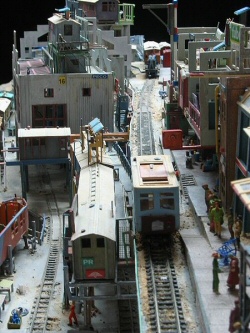 The Station, looking down on the Academy of Railway Arts and
Sciences and its wagonville, a shanty town composed of old railway carriages
The Station, looking down on the Academy of Railway Arts and
Sciences and its wagonville, a shanty town composed of old railway carriages
The first two modules, known as Kilometre Seven and
the Academy of Railway Arts and Sciences, were built
conventionally on rectangular bases 2 centimetres thick
in a homegrown honeycomb construction of cardboard, placed end to end and
fastened together with wooden battens. This module started life in a loft and
was fitted with castors to avoid falling into the stairwell.
The infrastructure of the Oasis, which was designed
and built in the workshop, consists of a dorsal spine made of cardboard, which
holds up the factories, with cardboard struts which hold up the curves of the
tracks as well as the mountain, which is hollow. The Oasis sits on a plywood
base (122 x 250 cm)
– but it can often be found hanging on the wall like a bas-relief.
The various elements of the ReFeRe are not fixed; they
are designed to be viewed in isolation, from all sides (no sky or painted
landscape as a backdrop) and placed at a convenient height of 1.30 metres.
Construction takes place without a detailed plan; the
layouts are drawn straight onto the paper or cardboard.
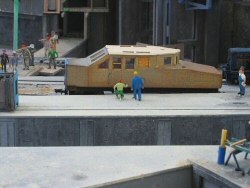 The Sneakmobile, surveillance railcar
The Sneakmobile, surveillance railcar
Exploitation
Trains can run and perform manoeuvres on all the
tracks. That is a condition which was set at the outset.
The motive power is provided by a transformer from a
model train set. All the points and other track installations (turntable,
sector plates, traverses, etc.), all actually work and are, literally,
digitally controlled – that is to say, worked with the fingers. Frogs are insulated; the power routing switch
– in front of the layout - is mechanically linked to points by a brass rod.
The movements of the trains are simple. On the Oasis,
in its exhibition setting, two trains run, on separate tracks, each in a
different direction, each powered by a transformer. They stop on demand. Places
for slowing down and stopping (breaks in the rails or cabling) are provided,
which could be controlled by a computer.
The constant comings and goings of the Sneakmobile
provide some excitement around the Nuclear Power Plant.
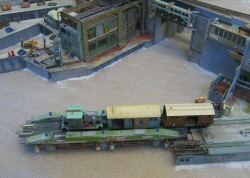 On the Oasis, the big green hovercar transports a train
On the Oasis, the big green hovercar transports a train
Interesting sites and installations
Customarily, the trains go past stations, apartment
blocks, workshops,pieces of waste ground, factories, fences... over bridges
(lots of these) and through tunnels (to cross the mountains), all distinguished
by their originality.
- The Turntable, inspired by devices which are
normally kept in hidden sidings on shelf layouts, enables several trains to be
turned and parked ;
- the premises of the Academy of Railway Arts
and Sciences (teaching, research, long-term planning), characterized by a
distinctive architectural leitmotiv and
the recycling of passenger coaches as
offices and workshops, placed above the tracks or on the roofs of the building,
forming a wagonville ;
- the Depository, a lonely islet where rejects and
waste are sorted, transported and thrown on a heap;
- the Hovercars, vehicles for transporting entire
trains, linking the islets, kept up by cushions of air, moored in the Hovercar
Harbour;
- the Adhesion Centre, an industrial complex where the
adhesive for concrète is manufactured;
- the Mine, a vast subterranean station, housing in
particular the underground premises of the kitchens ;
- the Nuclear Power Plant, terrifying but soon to be
entombed under unrecyclable waste in spite of the constant reshuffling this
waste undergoes.
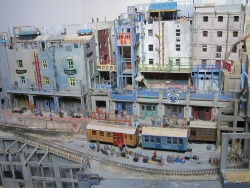 A downtown station at
Kilometre Seven
A downtown station at
Kilometre Seven
On Display
Three modules of the ReFeRe, the Academy, the Oasis et
the Nuclear Power Plant, have been on permanent exhibition at the Musée des
mondes imaginaires (Museum of Imaginary Worlds) / Atelier Alter Ego at Sauvigny in Burgundy since July
2011.
...
 The Oasis. In the foreground : the Adhesion Centre
The Oasis. In the foreground : the Adhesion Centre The Oasis. In the foreground : the Adhesion Centre
The Oasis. In the foreground : the Adhesion Centre



